2006 VOLKSWAGEN GOLF MK5 warning
[x] Cancel search: warningPage 336 of 444
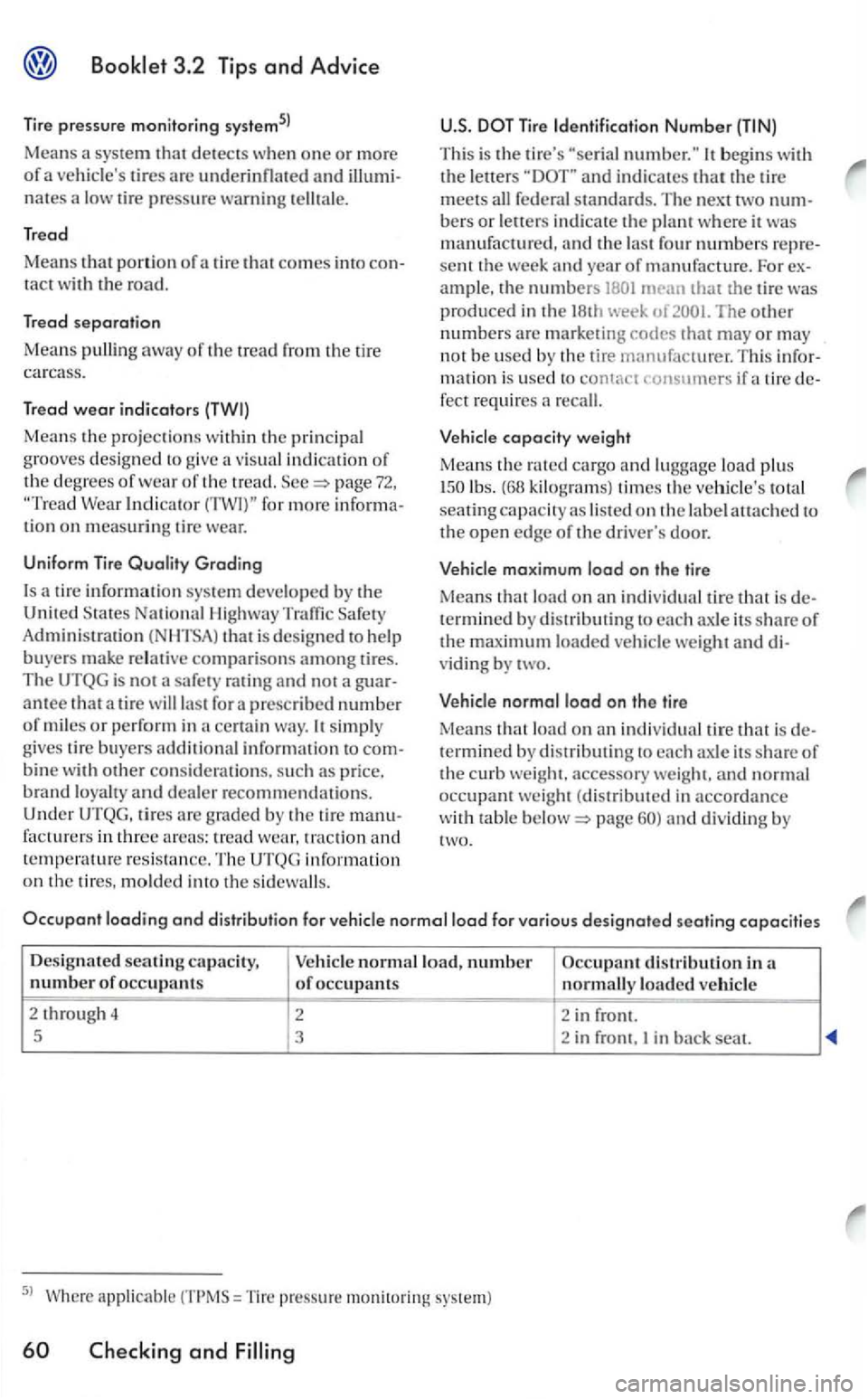
3.2 Tip s and Advice
Tir e pressure monitoring
tires are underinflated a nd nates a low tire pressure warning tellt ale.
Tread
Means that porti on of tire that comes into tact the road.
Tread separation
Means pulling away of the tread from the tire carcass.
Tread wea r indicators
visual indication of the degrees o f w ear of th e tread. page 72,
Wea r for more tio n on measurin g tire wear.
Un iform
Tire Quality Grading
that is designed to help buyers make re la ti ve comparisons among ti res. The UTQG is not s afety rating and not a
antee that a tire la st for a prescrib ed number of miles o r perform in simply
g ives tire buyers additional information to bin e w ith other consideratio ns. such as price. brand loya lty and dealer recommendations. Under UTQG, tires arc graded b y th e tire fac turers in three areas: tre ad wear, traction and temperature resistance. The UTQ G information o n the tires, molded into the s idewall s.
This is the tire's "ser ia l begin s w ith the letters
sent week and year of manufacture. For ample . the rnran that the tire
pro duced in the 18th The other numbers arc m arketin g codes that no t be used by th e tire manufacturer. T his mation is used to if a tir e fect requires a recall .
Vehicle
capacity weight
Means the cargo and load plu s lb s. (68 kilograms) times the total
s
eatin g capacity as lis ted on the label attached to the ope n edge o f the driver's door.
Vehicle
maximum load on the tire
Mean s that load o n an indi vidual tire that is t ermined b y di stri buting to each axle its share of the maxim um loaded weight and viding by
normollood on th e tir e
Means that load o n an indiv idual tire that i s termined by di stribut ing to axle its sh a re of the curb weigh t. accesso ry weight. and normal occupant weight (di stributed in accordance with table page and di viding by
Occupant loading and distribution for vehicle normal load
normal load, number Occupant distributio n in number of occupants of occupants normally loaded
2 through 4
2 2 in fro nt.
5
3 2 in front. I in
=Tire pres sure
Checking and
Page 338 of 444
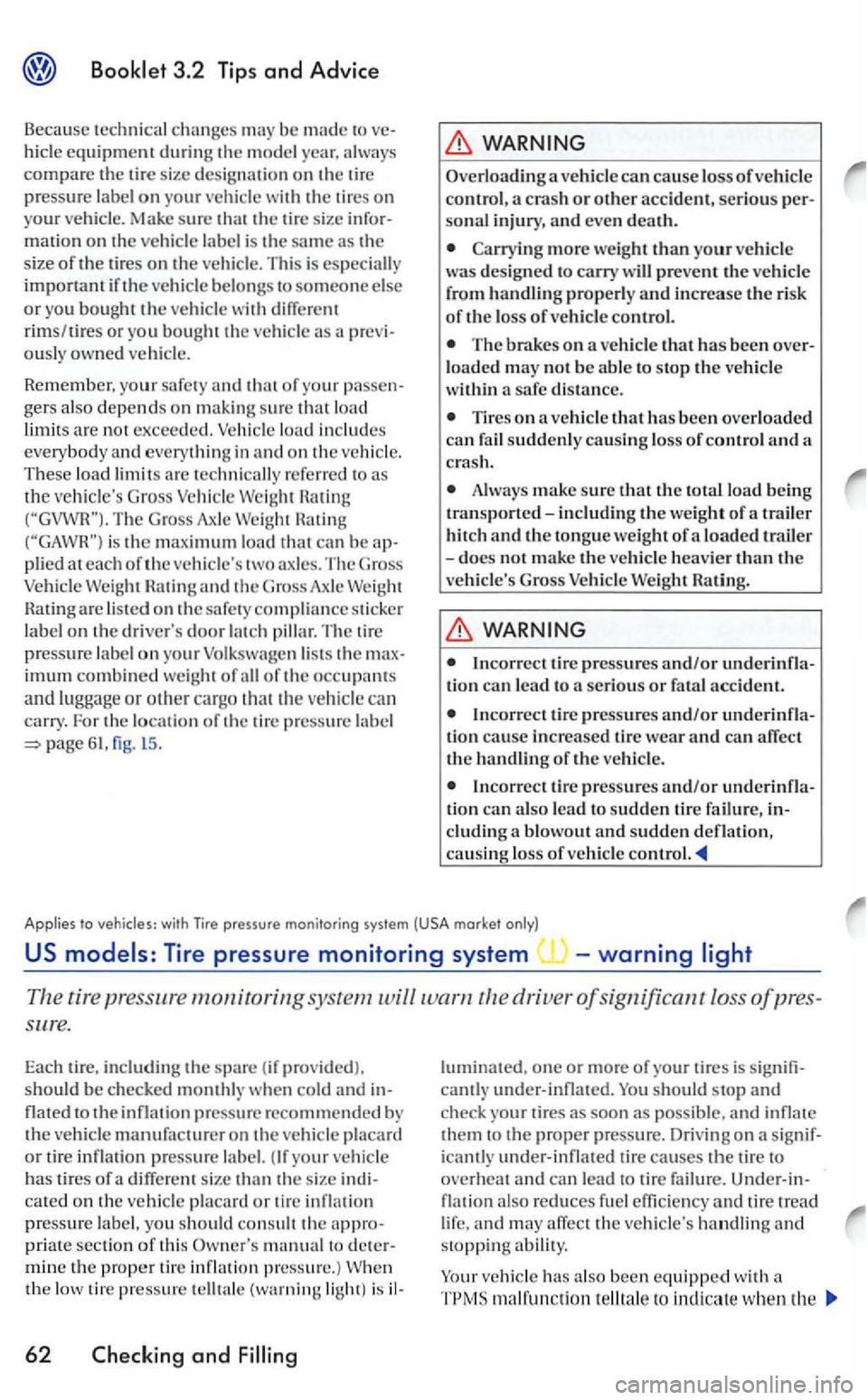
3.2 Tips and Advice
Because technical changes may be made to vehicle equipment during the model year, always compare the tire size desig nation on the tir e pressure label on your vehicle with the tire s on your vehicle. Make sure
a previousl y owned ve hicle.
Remember, your safe ty and t h at of your passengers also depends on making sure that load
limit s are not exceeded. Vehicle load includes everybody and everything in and on the vehicle.
T hese load limit s arc techni call y referred to the ve hicle's Gross Vehicl e Rating Hatin g is th e maximum load that
Hating are listed on th e s afet y compliance sticker
label on t h e driver's door
fig. l5 .
WARNING
Overloading a vehicl e can cause loss of vehicle control,
more we ight than your vehicle was des ign ed to carry w ill prevent the vehicle from handling properly and increase the risk of the loss of vehicle control.
The on a vehicle that has been over
loaded may not be abl e to stop the vehicle within a safe distance.
Tires on a vehicle that has been overloaded can fail suddenly cau sin g loss of control and a crash.
Always make sure that the total load being transp o rted-including the weight of a trailer hitch and the to ng u e weight of a loaded trailer -docs not make the vehicle heavie r than the vehicle's Gross Vehicle
WARNING
Inco rrect tire pressures and/or underinflation can lead t o serious or fata l accident.
Incorrect tire pressures and/or underinflation cause increased tire wear and can affect the ha nd lin g of the ve hicle.
Applies to
The tire pressur e monitoring syste m driver ofsignificantloss of pres
sure.
Each tire, including the spare ( if provided),
should be c heck ed
your vehicle has tire s of a diff erent s ize than the s ize indi cated on the vehicle placard or tire inflation pressure lab el, you should consult the appropriate sec tion of this
and
luminatcd. one or m ore of your tires is signifi
cantly under-inflated. should stop and check your tires as soon as possible , and inflate them to the pro p er p ressure. Driving on a sig nif
icantly under- inflated tire causes the tire to overheat and can lead to tire failure. Under- in-
flation al so reduces fuel effic iency and tire tread life , and may affe ct th e vehic le's handling stopping ability.
ve hicle has also been equipped with a malfunction te llt ale to indi cate when
Page 339 of 444
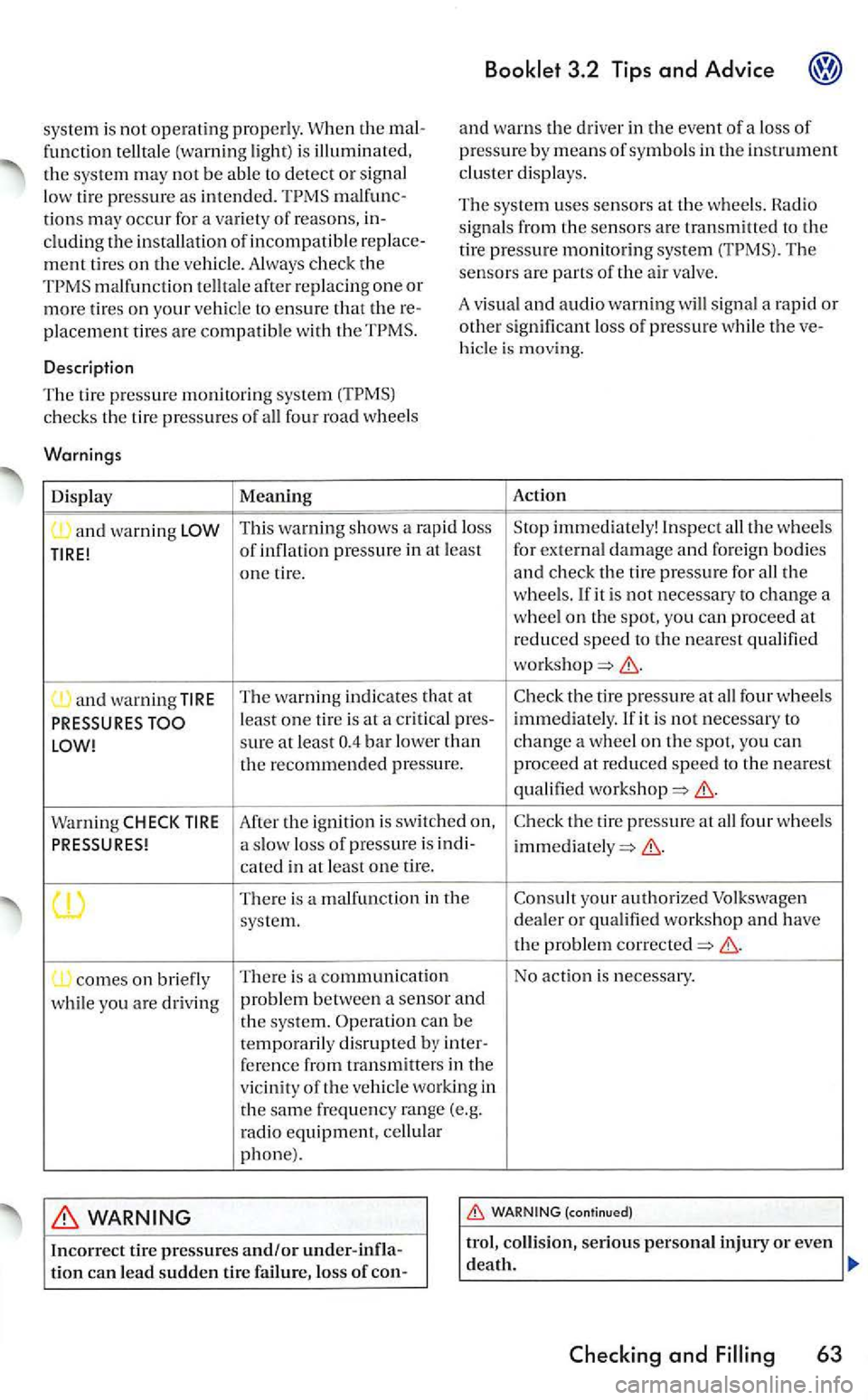
syste m is not operating properly. When the malfunct ion telltale (warning light) is illuminat ed, the system may not be able to detect or signal
low tire pressure as intended. malfunc
tions may occur for a var iety of reasons, including the installation of incompatible replacement tires on the vehicle. Always check the
and warns the driver in the event of a lo ss of pressu re by means of symbols in the instrument cluster dis plays.
Descri
ption
The system uses sensors at th e whee ls . Rad io
signals from the sensors are transmitted to the tire pressure monitoring system Th e sensors are parts of the air valve.
A visua l
and audio warning will signal a rapid or other significant loss of pressure while the ve
hicle is moving .
The tir e pressure monitorin g system
This warning shows a rapid loss Stop immediately! Inspect all the wheels
T
IRE! of i nflation pressure in at least for e
xt ernal damage and for eign bodies
one tire. and check the tire pressure for all the wheels. If it is not necessary to change a
w heel on th e spot, you can proceed at reduced speed the nearest qualified
and warnin g TIRE The warn ing indicates that at Chec
k the tire pressure at all fou r whee ls leas t one tire is at a criti ca l pres- immediately. If it is not necessary to sure at least
Warning CHECK TIRE After the ig n it ion is switched Check the tire pressure at all fou r wheels a slow loss of pressure is indi-
There is a malfunct ion in the Consult your a uthorized Volkswagen
system. dealer or qualified workshop and have
the p ro ble m corrected
comes on briefly There is a communica tion No action i
s necessaty.
while you are
driving problem between a sensor and the system. Operation can be temporarily di srupted by inter-
f ere nce from transmitters in the
v icinity of the vehicl e working in
t h e same frequency range (e.g.
rad io equipment, cell ula r phone).
WARNING
Checking and 63
Page 341 of 444
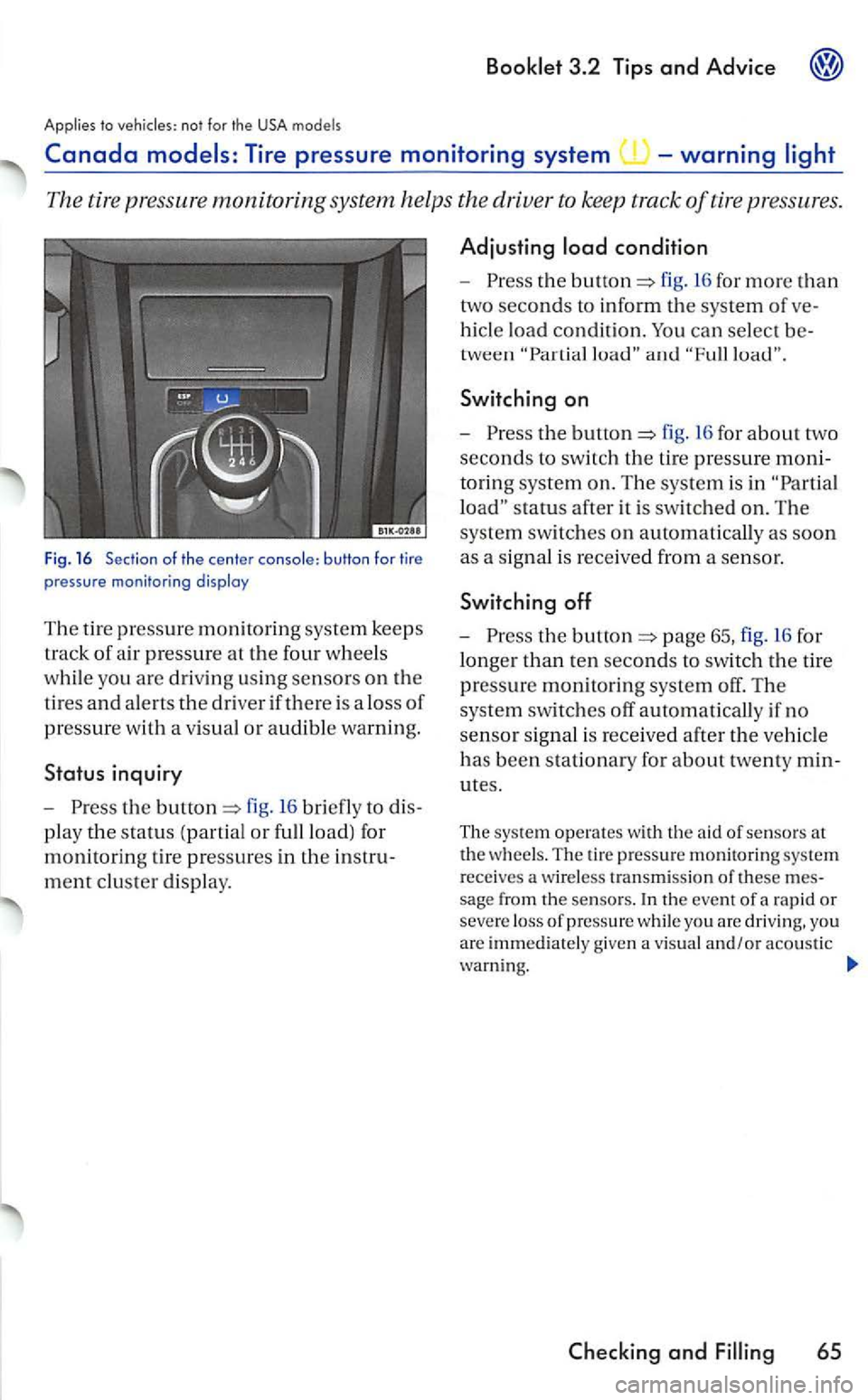
to the USA models
The tire pressure monitoring system helps the driver to keep track of tire pressures.
Fig. 16 Section of the center console: button for tire
p ressure monitoring disploy
T he tir e pressure monitoring system keep s
track
of air pressure at the four wheels
w hil e yo u
are driving using sen so rs on th e
tir
es and alerts the dri ver if th ere is a lo ss of
pressure with a visual or audibl e warning.
Status inquiry
-
play the status (partial or full load) for
m
onito ring tir e press ures in the
ment clu ster display.
Adjusting
the fig. 16 for more than
two seconds to inform th e system of
hicle load condition.
Switching on
-the fig. 16 for about two
seconds to switch the tire press ure
tori ng syste m on. The system is in
after it is switched o n. The
system
switches on autom atic ally as soon
as a sig nal is receive d from a sensor.
Switching off
-page 65, fig. 16 for
lo nger than te n seconds to switch th e ti re
pressure monito ring system off. The
system switches off automatically if no
sensor sig na l i s received aft e r th e vehicle
has been statio nary for about twenty
th e a id of se nso rs at t h e w heels . The tir e pressure monitoring syste m
rece ives a wireless transmissio n of these sage from the senso rs. In the event of a rapid or severe loss of pressu re wh ile yo u are driving, you are immediately given a visual and/or acoust ic
warning .
65
Page 342 of 444
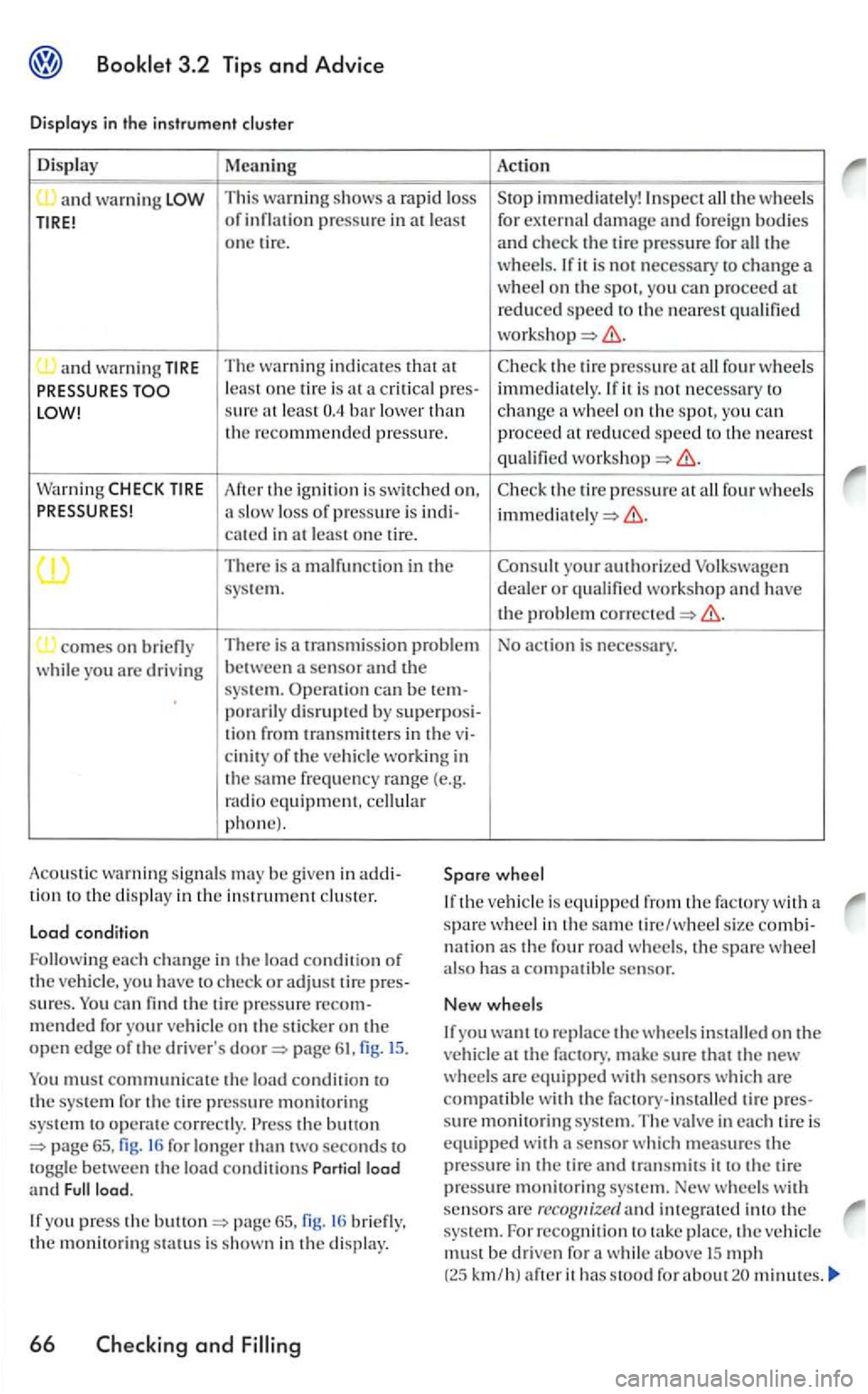
3.2 Tips and Advice
Displays in the instrument
Display Meaning Act io n -and warni ng T hi s warning shows a rapid loss immediately! In spect the wheels of p ressure in least for external damage and for eign bodies
o ne tir e. and check th e tire pressure for th e wheels. If it is not necessary to change a wheel on the spot, you pro ceed at
reduced s p e ed to the nea re st
and warnin g TIRE The warning ind ic a tes that at Check th e tire pressure at four wheels
sure at least
Warn ing After the ignition is switched on. Check th e tire pressure at four wheels a slow loss of pressure is in di-ca tcd in at le a st one tire.
T here is a malfunction in the your authorized Volkswagen
sys tem. dealer o r
comes o n
disrupted by superposi-
tion from transmi tters in the
the same frequency range (e.g.
rad io equipment. phone).
Load condition
Followi ng
each change in th e load conditio n of
th e yo u have check or adjust tir e sure s. can
page
mus t communicate th e load condition to the sys te m for the tire pressure monitoring system to operat e correctly. the bullon 16 for lo nger th an two seconds to
If you press the bullon briefly. th e monitoring status is shown in the display.
66
wheel
If the vehicle is equipped the fac tory with a
spare wheel in th e same tire /wheel s ize
you re place the w heels o n the at the factory. make sure that the new
w heels are equipped with se nsors whic h are compatible with the factory-installe d tire sure monitoring sys te m. The val ve in each tire is equipped with
mus t be dri ven for a while above mph (25 km/h ) after it has s tood fo r about
Page 343 of 444
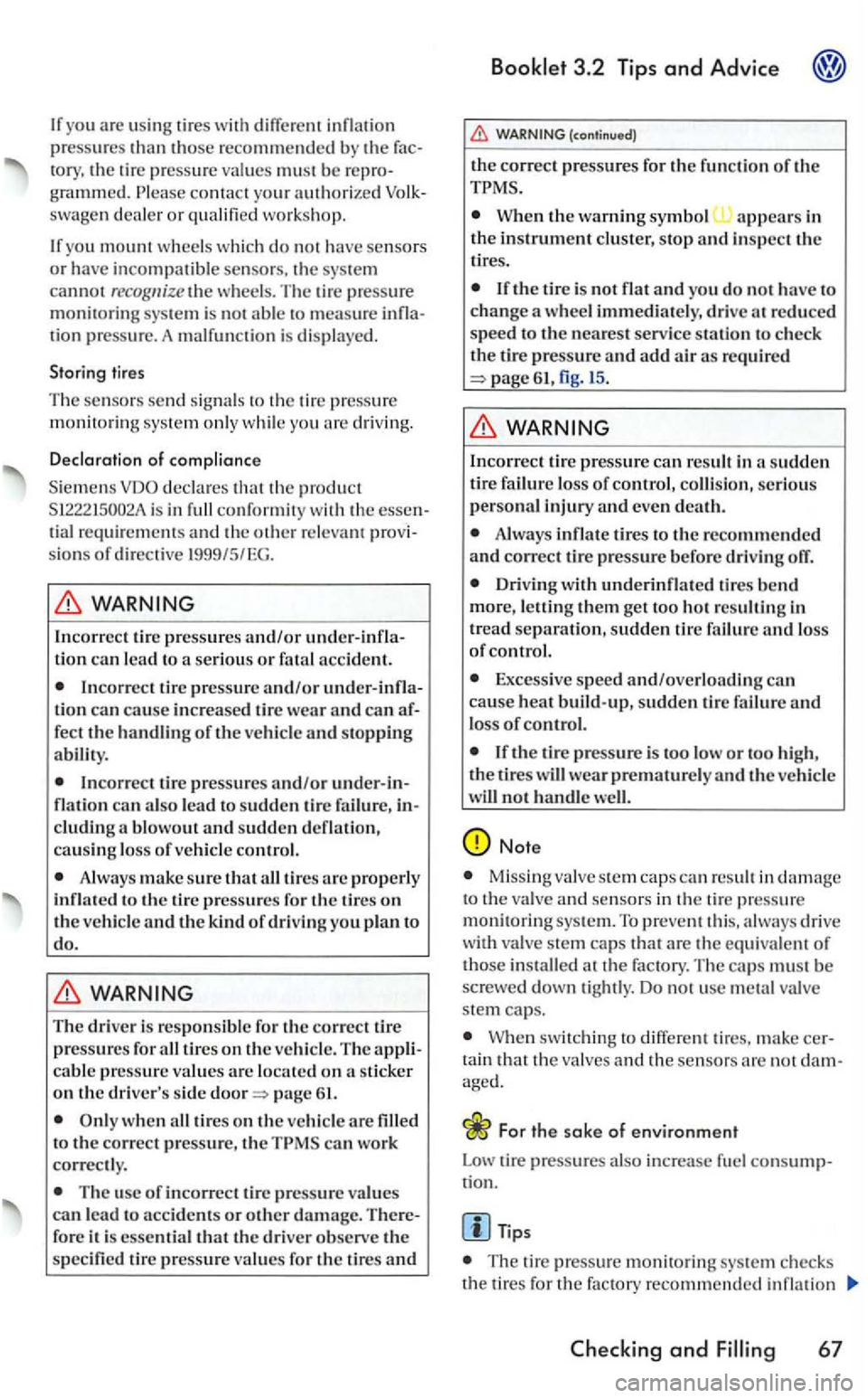
you are using tires w ith inflatio n
p ressures than those recommended by the tory, the tir e press ure val ues must be re programmed. swagen dealer or q ualified workshop.
you mount wheels whic h d o not have sen sors or have incompatible sensors . th e sys tem cannot recognize the wheel s. The tir e pressure monitoring sys te m is not abl e to measure infla
tion press ure. A malfun ction is di sp la ye d.
S t
oring tires
T he se nsors se nd signa ls to t h e tir e press ure
monitori ng sys te m only whi le you arc driv ing .
D eclaration of complianc e
Siemens declares that the product is in full c onfo rmit y w ith the essential requi rements and the other re levant prov i
sio ns of directi ve 19 99/5/EG.
WARNING
In correc t tire pressures and/or unde r- inflati o n can lead t o
an d can
Incorrect t ire p ressures and/o r under-i n
flatio n ca n also lead to sudden tir e failure, bl owout and sudden d eflati on, causing loss of ve hicl e control.
Always make sure that a ll tires are properl y
inflat ed t o tire press ures fo r th e tires o n
t h e vehicl e and the kind of driv in g yo u plan to
do.
WARNING
The d rive r is responsib le for the correct tire
press ures for all tires on th e ve hicle. The cable pressure values arc loc ate d on sticke r
o n the dri ver's sid e page 61.
correctly.
The use of in correct tire pressure values can lead to acci den ts or other damage. There
f o re it i s esse ntial that the d river observe the
s p ecified tire p ressure va lues fo r the tires an d
Booklet 3.2 Tips and Advice
WARNI NG (continued)
the correc t pressures fo r the functi on of the
W hen the
the ti re is not flat and you do no t have to
c h an ge a w heel immed ia tely, drive
required fig. 15.
WARNING
Incorrect tire pressure can result in sudde n
t ire failur e loss of control, co llisio n, seri ous
personal i njury an d even death.
A lways in flat e tires to the recommended and correct tire pressure before dri ving
D rivi ng with unde rinfl atc d ti res b end m ore, le ttin g them get too h o t res ulting in tread sep aration, sudden tire failure and loss
o f co ntrol .
Exces sive speed and/ overloading can cause heat build-up , sudden tire fa ilure a nd
l oss of control.
not handl e we ll.
Missin g valve ste m caps can resu lt in damage to th e va lve and sensor s in the tire pressure mon itorin g sys te m. To pre vent t his, alwa ys dri ve
with valve stem caps that are the equi valent of th ose insta lled va lve
s te m caps.
Whe n switc hin g to t a in that the va lve s and the sensors not aged.
For the sake of environment
Low tire pressures also increase fuel consump
tion.
The tire pressu re monitoring syste m checks
th e tires for the fac tory recommend ed inflation
Page 346 of 444
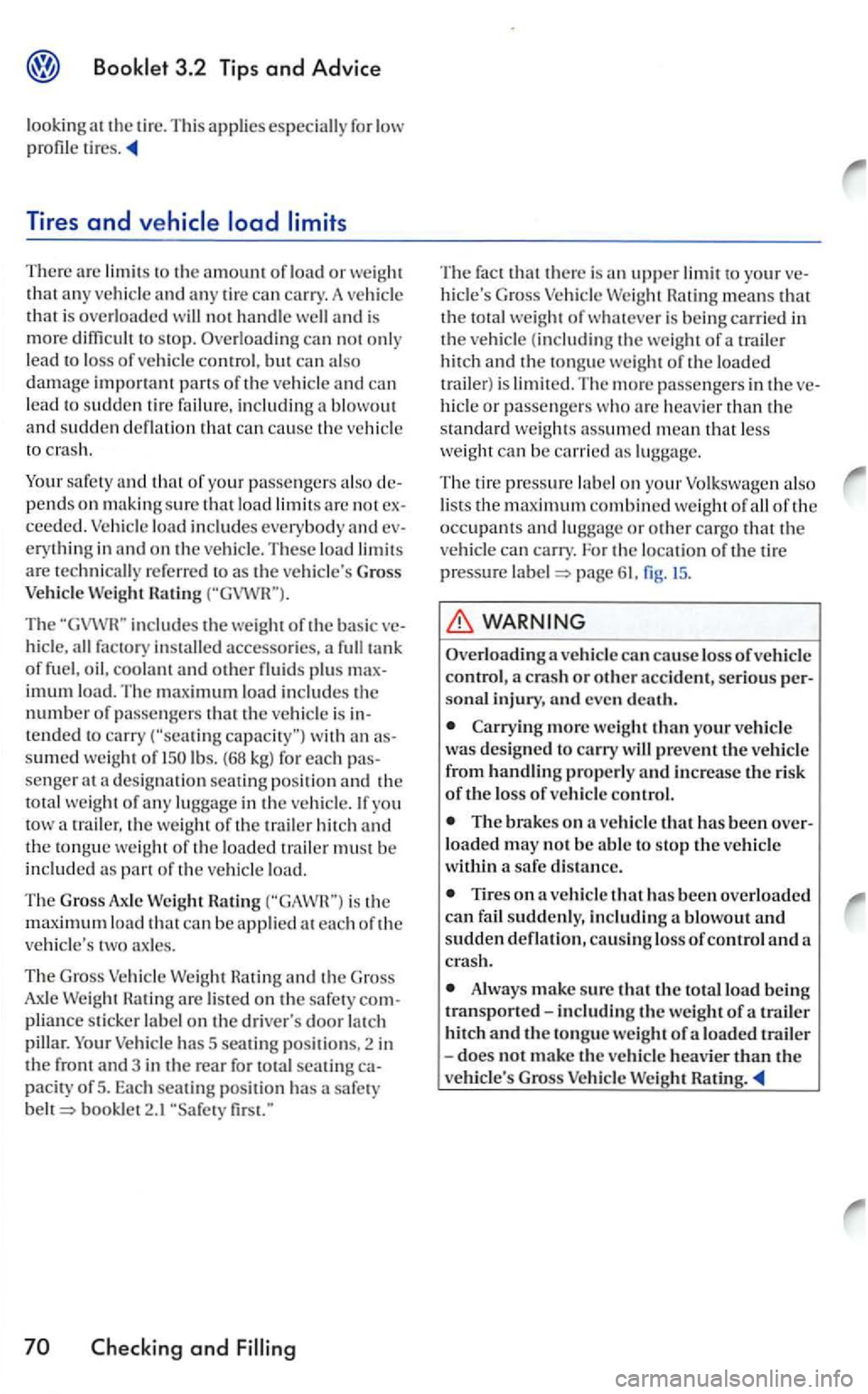
Tires and
There arc limits to th e amount of load or weig ht that any vehicl e and any tire can carry. A ve hicle that is overloaded will not handle well and is mor e to stop. Overloading can not only
lead l oss of ve hicle control. but ca n al so damage including a blowout
and s udden d eflatio n th at can cause the vehicl e
to crash .
Your safet y
and that of your passengers also de
pends on making sure th a t l oad limit s arc not exceeded. load in cludes everybody and everyth in g in and on the vehicle. These load limit s are technically refe rred to as th e vehicle' s Gr oss Ratin g
includes the weight of the basic veall factory installed accessorie s. a full tank of coolant and other fluids plus maximum load. The m ax imum load incl udes the number of passengers that the ve hicle is in tended to carry lbs. (68 kg) for each passenger at designation seating position and the
total wei ght of a ny lu ggage in the ve hicle. yo u the weig ht of the trailer hit ch and the tongue weight of the loaded trailer mus t be included o f the ve hicle load.
T he Gross
Axle is the m aximum load th at can be ap plied at each of the
veh icle's two
has 5 seat ing pos ition s, 2 in the front and 3 in the rear for seating capaciry of 5. Eac h seatin g posit ion ha s a sa fe ty bookle t2.1
and
The fact that there is an upper li mit to your ve
hi cle's Gross Hating means that the total weight of whatever i s bein g carried in the vehicle (in cluding the weight of a trailer hit ch and the tongue weig ht o f the load ed
t railer) is limited. The more passengers in the ve
hicl e or passengers are heav ier than the standard weig hts assumed mean that less weig ht can be carried lu ggage.
The tire pressure on your Volkswage n also lists the maximum combined weight of all of the occupants and
page fig . 15 .
WARNING
Overloading a ve hicl e can cause loss of vehicle control, a crash or other accident, serious pe r
sonal injury, nnd even dent h.
more weight than your vehicle was d esig ne d to carry will prevent th e ve hicl e
fr om handling properl y and increase the ri sk of th e loss of ve hicl e control.
The brakes on a ve hicl e that has been overloaded may not be abl e to sto p the ve hicle
w ithi n a safe di stance.
o n a ve hicle that has been overloaded can
Alway s make sure that the to tal load bein g transported-including the weight of a trail er hitch and the tongu e weight of a loaded trail er -does no t m ake th e ve hicle heavier t11e
ve hicl e's Gross Vehicle Rating .
Page 357 of 444
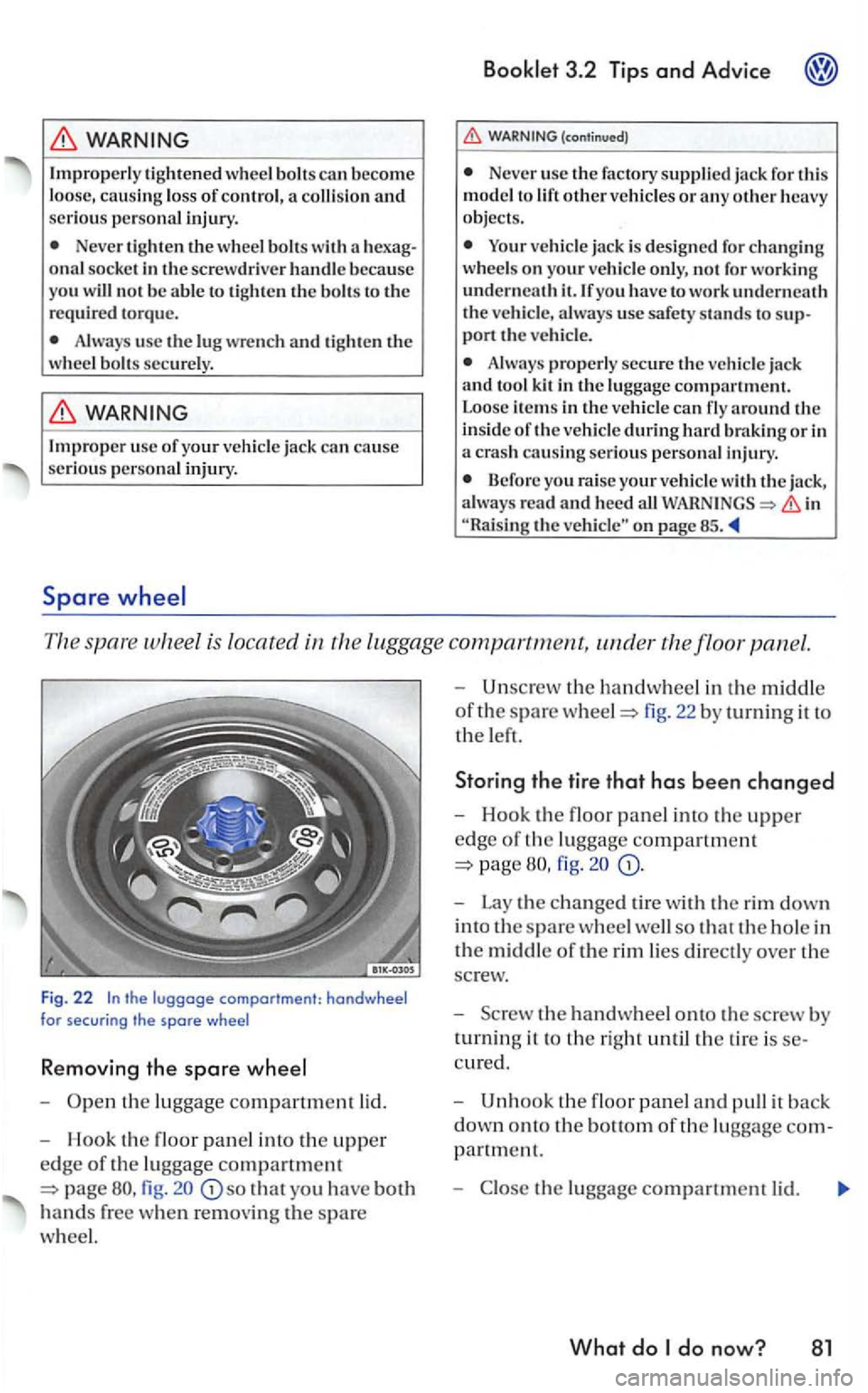
WARNING
Improperly tighten ed wheel bo lts can become loose, causin g lo ss of cont rol, a colli sio n an d seriou s perso nal injury.
Never tigh ten the wheel bolts with a onal socke t in th e screw driver han dle beca use
yo u will not be abl e to tighte n the bo lts to the
req uired torque .
WARNING
Improper use of your vehicle jack can ca use seriou s perso na l i njury.
Spare
3.2 Tips and Advice
(continued)
Never use the factory su pplied
port th e veh icle .
Alway s properly secure the vehi cle jack and tool k it in th e lu ggage com pa rtm ent .
Loose ite m s in th e ve h icle can fly a round the in side of th e vehicl e during hard braki ng or in a c rash causin g serious pe rso na l inju ry.
in th e ve hicle" on page 85.
spare is located in t h e luggage compartment, the floor panel.
F ig. 22
-
fig. so that yo u h ave both
hands free when removin g the spare
w h
eel.
-Unscrew th e hanclwhee l in the m iddle
of the spare fig. 22 by turning it to
t h e left.
Storing the tire that has been changed
-Hook the floor panel into th e upper
edge of th e lu ggage compartment
page
-Lay the changed tire with th e rim down
i n to
the spare wheel well so that th e hole in
the middl e of th e rim lies directly over t h e
sc r
ew.
- Scr
ew the hand wheel onto th e screw b y
t
urni ng it to the right until the tire is
partment.
- C lose the luggage compartment lid.
What do do n ow? 81